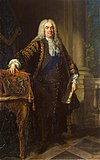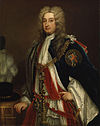John Campbell, 2nd Duke of Argyll
Jacobite rebellion of 1715 | |
|---|---|
| Spouse(s) | Mary Brown Jane Warburton |
| Issue | 4 daughters, including Caroline and Mary |
| Parents | Archibald Campbell, 1st Duke of Argyll Elizabeth Tollemache |

Early life
Born at
Early military career
Campbell was commissioned, after his father had given William III some encouragement, as colonel of Lord Lorne's Regiment of Foot, a regiment entirely raised by the Argyll family, on 7 April 1694.[2] He served briefly on the European continent in the Nine Years' War before the regiment was disbanded in 1698.[3] He also served under the Duke of Marlborough at the Siege of Kaiserswerth[4] in April 1702 during the War of the Spanish Succession.[3] He was appointed a Knight of the Order of the Thistle later that year.[2]
Campbell succeeded his father as Duke of Argyll and Chief of
Appointed a
After conducting a successful evacuation of the troops from Spain he became
Jacobite uprising

During the Jacobite Rebellion, Campbell led the government army against the Jacobites led by the Earl of Mar at the Battle of Sheriffmuir in November 1715.[6] The battle was indecisive but favoured the government strategically. He led the advance against the Jacobite capital of Perth, capturing it in December with little bloodshed, but was then replaced as commander by William Cadogan.[8]
Later career
Campbell arrived back in London early in March 1716, and at first stood high in the king's favour, but in a few months was stripped of his offices. This, however, did not deter him from the discharge of his parliamentary duties; he supported the bill for the impeachment of Bishop Atterbury, and lent his aid to his countrymen by opposing the bill for punishing the city of Edinburgh for the Porteous Riots. In the beginning of the year 1719 he was again admitted into favour, and in April was created Duke of Greenwich.[6][5]
He went on to become
In the 1720s he commissioned the architect
Promoted to field marshal on 31 January 1735,[14] Campbell was stripped of his post as Master-General of the Ordnance and the colonelcy of the Royal Horse Guards for opposing the Government of Robert Walpole in 1740.[15] However he was restored to his post as Master-General of the Ordnance in February 1741[16] and restored to his colonelcy a few days later.[17] However, disapproving the measures of the new administration, and apparently disappointed at not being given the command of the army, he shortly resigned all his posts, and spent the rest of his life in privacy and retirement.[5]

Campbell died at Sudbrook Park, Petersham on 4 October 1743 and was buried in Westminster Abbey; his grave is marked by a small lozenge stone to the north east of Henry VII's tomb. A large monument, designed by the French sculptor, Louis-François Roubiliac, was erected for him in the south transept and unveiled in 1749.[1]
Argyll Street in London's West End is named after him.[18]
Family

Campbell married first, Mary Brown, daughter of John Brown and Ursula Duncombe, in 1701: they separated soon after the marriage and she died in 1717 and was buried in Westminster Abbey.[1] He married in 1717 secondly, Jane Warburton, daughter of Thomas Warburton and Anne Williams, sister of Hugh Warburton and maid of honour to Queen Anne; Jane died in 1767 and was buried with him in Westminster Abbey.[19] He had four daughters who reached maturity: Caroline Townshend, 1st Baroness Greenwich, Lady Elizabeth Campbell, Lady Anne Campbell and Lady Mary Coke.[20]
In popular culture
Campbell is played by
References
- ^ a b c d "John Campbell, 2nd Duke of Argyll". Westminster Abbey. Retrieved 27 July 2014.
- ^ required.)
- ^ a b c Heathcote, p. 71
- ^ "The Campbells of Argyll". electricscotland.com. Retrieved 29 February 2024.
- ^ a b c Yorke & Chisholm 1911.
- ^ a b c d e f g h i j k Heathcote, p. 72
- ^ "The Treaties of Utrecht (1713)". Heraldica. Retrieved 26 September 2019.
- ^
 This article incorporates text from a publication now in the public domain: "Cadogan, William (1675-1726)". Dictionary of National Biography. London: Smith, Elder & Co. 1885–1900.
This article incorporates text from a publication now in the public domain: "Cadogan, William (1675-1726)". Dictionary of National Biography. London: Smith, Elder & Co. 1885–1900.
- ^ "No. 6378". The London Gazette. 1 June 1725. p. 1.
- ^ "No. 6506". The London Gazette. 23 August 1726. p. 1.
- ^ "No. 6932". The London Gazette. 3 November 1730. p. 1.
- ^ "No. 7219". The London Gazette. 4 August 1733. p. 3.
- ^ "The Clubhouse". The Richmond Golf Club. Retrieved 5 December 2012.
- ^ "No. 7476". The London Gazette. 27 January 1735. p. 1.
- ^ Heathcote, p. 73
- ^ "No. 8094". The London Gazette. 16 February 1741. p. 2.
- ^ "No. 8096". The London Gazette. 23 February 1741. p. 7.
- ^ Weinreb, Ben; Hibbert, Christopher (1992). The London Encyclopaedia (reprint ed.). Macmillan. p. 25.
- ^ Stanley, A.P., Historical Memorials of Westminster Abbey (London; John Murray; 1882), p. 231.
- ^ Mosley, p. 607
- IMDb
- IMDb
Sources
- Hugill, J.A.C. No Peace Without Spain. Kensal Press, 1991.
- Heathcote, Tony (1999). The British Field Marshals 1736-1997. Pen & Sword Books Ltd. ISBN 0-85052-696-5.
- Mosley, Charles (2003). Burke's Peerage, Baronetage & Knightage, 107th edition, Volume I. Burke's Peerage (Genealogical Books). ISBN 978-0971196629.
- This article incorporates text from a publication now in the public domain: Yorke, Philip Chesney; Chisholm, Hugh (1911). "Argyll, Earls and Dukes of s.v. John Campbell, 2nd duke of Argyll and duke of Greenwich". In Chisholm, Hugh (ed.). Encyclopædia Britannica. Vol. 2 (11th ed.). Cambridge University Press. p. 485.


